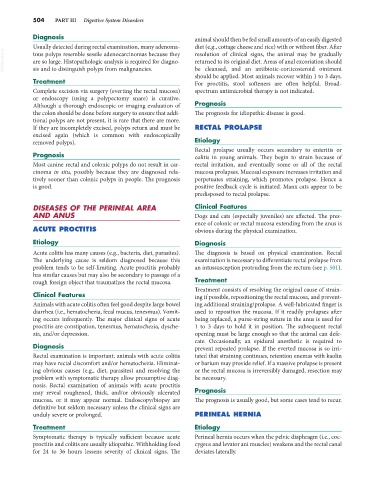Page 532 - Small Animal Internal Medicine, 6th Edition
P. 532
504 PART III Digestive System Disorders
Diagnosis animal should then be fed small amounts of an easily digested
Usually detected during rectal examination, many adenoma- diet (e.g., cottage cheese and rice) with or without fiber. After
VetBooks.ir tous polyps resemble sessile adenocarcinomas because they resolution of clinical signs, the animal may be gradually
returned to its original diet. Areas of anal excoriation should
are so large. Histopathologic analysis is required for diagno-
be cleansed, and an antibiotic-corticosteroid ointment
sis and to distinguish polyps from malignancies.
should be applied. Most animals recover within 1 to 3 days.
Treatment For proctitis, stool softeners are often helpful. Broad-
Complete excision via surgery (everting the rectal mucosa) spectrum antimicrobial therapy is not indicated.
or endoscopy (using a polypectomy snare) is curative.
Although a thorough endoscopic or imaging evaluation of Prognosis
the colon should be done before surgery to ensure that addi- The prognosis for idiopathic disease is good.
tional polyps are not present, it is rare that there are more.
If they are incompletely excised, polyps return and must be RECTAL PROLAPSE
excised again (which is common with endoscopically
removed polyps). Etiology
Rectal prolapse usually occurs secondary to enteritis or
Prognosis colitis in young animals. They begin to strain because of
Most canine rectal and colonic polyps do not result in car- rectal irritation, and eventually some or all of the rectal
cinoma in situ, possibly because they are diagnosed rela- mucosa prolapses. Mucosal exposure increases irritation and
tively sooner than colonic polyps in people. The prognosis perpetuates straining, which promotes prolapse. Hence a
is good. positive feedback cycle is initiated. Manx cats appear to be
predisposed to rectal prolapse.
DISEASES OF THE PERINEAL AREA Clinical Features
AND ANUS Dogs and cats (especially juveniles) are affected. The pres-
ence of colonic or rectal mucosa extending from the anus is
ACUTE PROCTITIS obvious during the physical examination.
Etiology Diagnosis
Acute colitis has many causes (e.g., bacteria, diet, parasites). The diagnosis is based on physical examination. Rectal
The underlying cause is seldom diagnosed because this examination is necessary to differentiate rectal prolapse from
problem tends to be self-limiting. Acute proctitis probably an intussusception protruding from the rectum (see p. 501).
has similar causes but may also be secondary to passage of a
rough foreign object that traumatizes the rectal mucosa. Treatment
Treatment consists of resolving the original cause of strain-
Clinical Features ing if possible, repositioning the rectal mucosa, and prevent-
Animals with acute colitis often feel good despite large bowel ing additional straining/prolapse. A well-lubricated finger is
diarrhea (i.e., hematochezia, fecal mucus, tenesmus). Vomit- used to reposition the mucosa. If it readily prolapses after
ing occurs infrequently. The major clinical signs of acute being replaced, a purse-string suture in the anus is used for
proctitis are constipation, tenesmus, hematochezia, dysche- 1 to 3 days to hold it in position. The subsequent rectal
zia, and/or depression. opening must be large enough so that the animal can defe-
cate. Occasionally, an epidural anesthetic is required to
Diagnosis prevent repeated prolapse. If the everted mucosa is so irri-
Rectal examination is important; animals with acute colitis tated that straining continues, retention enemas with kaolin
may have rectal discomfort and/or hematochezia. Eliminat- or barium may provide relief. If a massive prolapse is present
ing obvious causes (e.g., diet, parasites) and resolving the or the rectal mucosa is irreversibly damaged, resection may
problem with symptomatic therapy allow presumptive diag- be necessary.
nosis. Rectal examination of animals with acute proctitis
may reveal roughened, thick, and/or obviously ulcerated Prognosis
mucosa, or it may appear normal. Endoscopy/biopsy are The prognosis is usually good, but some cases tend to recur.
definitive but seldom necessary unless the clinical signs are
unduly severe or prolonged. PERINEAL HERNIA
Treatment Etiology
Symptomatic therapy is typically sufficient because acute Perineal hernia occurs when the pelvic diaphragm (i.e., coc-
proctitis and colitis are usually idiopathic. Withholding food cygeus and levator ani muscles) weakens and the rectal canal
for 24 to 36 hours lessens severity of clinical signs. The deviates laterally.

